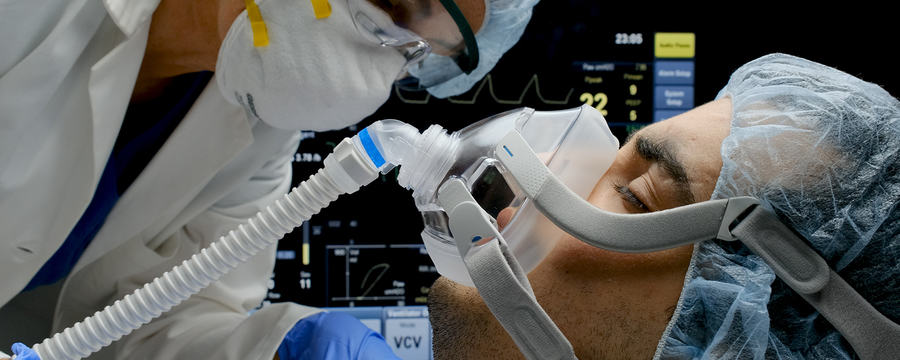Transmission and Policy

Share this step
Understanding how COVID-19 is transmitted is fundamental to forecasting how the pandemic will develop and spread.
The World Health organisation [1] gives the following definitions and information on the transmission of COVID-19:
Symptomatic transmission By way of definition, a symptomatic COVID-19 case has developed signs and symptoms compatible with COVID-19 virus infection. Symptomatic transmission refers to transmission from a person while they are experiencing symptoms.
Data from published epidemiology and virologic studies provide evidence that COVID-19 is primarily transmitted from symptomatic people to others who are in close contact through respiratory droplets, by direct contact with infected persons, or by contact with contaminated objects and surfaces.
Data from clinical and virologic studies that have collected repeated biological samples from confirmed patients provide evidence that shedding of the COVID-19 virus is highest in upper respiratory tract (nose and throat) early in the course of the disease, i.e. within the first 3 days from onset of symptoms. Preliminary data suggests that people may be more contagious around the time of symptom onset as compared to later on in the disease.
Pre-symptomatic transmission The incubation period for COVID-19, which is the time between exposure to the virus (becoming infected) and symptom onset, is on average 5-6 days, however it can be up to 14 days. During this period, also known as the “presymptomatic” period, some infected persons can be contagious. Therefore, transmission from a pre-symptomatic case can occur before symptom onset.
In a small number of case reports and studies, pre-symptomatic transmission has been documented through contact tracing efforts and enhanced investigation of clusters of confirmed cases. This is supported by data suggesting that some people can test positive for COVID-19 from 1-3 days before they develop symptoms. Thus, it is possible that people infected with COVID-19 could transmit the virus before significant symptoms develop. It is important to recognize that pre-symptomatic transmission still requires the virus to be spread via infectious droplets or through touching contaminated surfaces.
Asymptomatic transmission An asymptomatic laboratory-confirmed case is a person infected with COVID-19 who does not develop symptoms. Asymptomatic transmission refers to transmission of the virus from a person, who does not develop symptoms. [1]
Possible policies for containment?
- avoid or mitigate contact with contaminated objects and surfaces
- separate symptomatic people from others
Washing hands for 20 seconds is central to the expanded public awareness campaign to prevent and slow the spread of coronavirus (COVID-19). This phase of the campaign focuses on the importance of washing your hands more often, especially:
- when you get to work or arrive home
- after you blow your nose, cough or sneeze
- before you eat or handle food [2].
Social distancing measures are steps you can take to reduce social interaction between people. This will help reduce the transmission of coronavirus (COVID-19). They are to:
- Avoid contact with someone who is displaying symptoms of coronavirus (COVID-19). These symptoms include high temperature and/or new and continuous cough
- Avoid non-essential use of public transport when possible
- Work from home, where possible. Your employer should support you to do this. Please refer to employer guidance for more information
- Avoid large and small gatherings in public spaces, noting that pubs, restaurants, leisure centres and similar venues are currently shut as infections spread easily in closed spaces where people gather together.
- Avoid gatherings with friends and family. Keep in touch using remote technology such as phone, internet, and social media
- Use telephone or online services to contact your GP or other essential services
We strongly advise you to follow the above measures as much as you can and to significantly limit your face-to-face interaction with friends and family if possible, particularly if you:
- are over 70
- have an underlying health condition
- are pregnant [3]
Hand-washing and voluntary social-distancing are excellent policies and later we will discuss how, with the benefit of hindsight, they seem to have been very effective.
Lockdown is social distancing enforced by law. This includes staying away from work, not going to restaurants and pubs, and staying away from their families. Lockdown has been implemented by many countries. Although it seems to have been effective in controlling the spread of the virus, it has damaged the economies of many countries and is unpopular with large numbers of citizens.
What do you think
What would be your policy for the epidemic? How could you know if your policies would work? How would you set about modelling the spread of an epidemic? What kind of data would you need, and where would you find it? How would you analyse the data? Even if you’re not an expert let us know what you think.
References
[1] World Health Authority ‘Coronavirus disease 2019 (COVID-19), Situation Report – 73 2 April 2020. https://www.who.int/docs/default-source/coronaviruse/situation-reports/20200402-sitrep-73-covid-19.pdf?sfvrsn=5ae25bc7_2
[2] Department of Health and Social Care. ‘Public information campaign focuses on handwashing’, 4 March 2020. https://www.gov.uk/government/news/public-information-campaign-focuses-on-handwashing
[3] Public Health England, ‘Guidance on social distancing’, Updated 30 March 2020. https://www.gov.uk/government/publications/covid-19-guidance-on-social-distancing-and-for-vulnerable-people/guidance-on-social-distancing-for-everyone-in-the-uk-and-protecting-older-people-and-vulnerable-adults
Share this
COVID-19: Pandemics, Modelling, and Policy


Reach your personal and professional goals
Unlock access to hundreds of expert online courses and degrees from top universities and educators to gain accredited qualifications and professional CV-building certificates.
Join over 18 million learners to launch, switch or build upon your career, all at your own pace, across a wide range of topic areas.
Register to receive updates
-
Create an account to receive our newsletter, course recommendations and promotions.
Register for free







